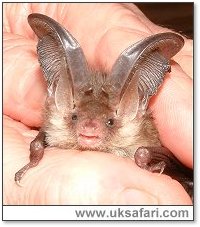
|

|
|
 Sent
to you Sent
to you
by e-mail
|
|
Simply
enter your details and hit the send button
more
info |
|


Click Here

Links
Advertise
Terms of Use
Contributors
About Us
Contact Us
|
 |
Go back
 | Bookmark
| Bookmark
 | Print Page
| Print Page  | E-Mail Us
| E-Mail Us 
 

Photo: G. Bradley |
|
UK
Safari Tip:
Find out about all the UK bat species with the fold out ID chart called
"A Guide to British Bats" in the Nature Shop - click
here
|
|
Latin name: Plecotus Auritus
Size: Wingspan approximately 25 to 33cms. Head and body around 45mms. Ears approximately 30mms tall.
Distribution: Found throughout the UK.
Months seen: April to October
Food: Beetles, moths, spiders, flies and midges.
Habitat: Roosts in old buildings.
Echolocation Frequency: 40 - 45 kHz
Special features: A small bat, sometimes called 'the whispering bat' because the ultrasound it produces for locating prey is much quieter.
The large ears feature a long pointed tragus. They are so highly tuned that they can distinguish between an insect and the leaf on which it rests. This allows the bat to pick up resting moths.
The ultrasound is emitted through the nostrils, and the inside edges of the ears have tiny hairs which help to receive the vibrations coming
back.

UK Safari Bat Section
Bat
Identification Charts
Bat Calls on CD - Learn to Identify Species
Bat Detectors
What is a bat?
What is Echolocation?
What does a bat sound like?
What is a tragus?
Links to Bat Groups in Britain
|
 |

|